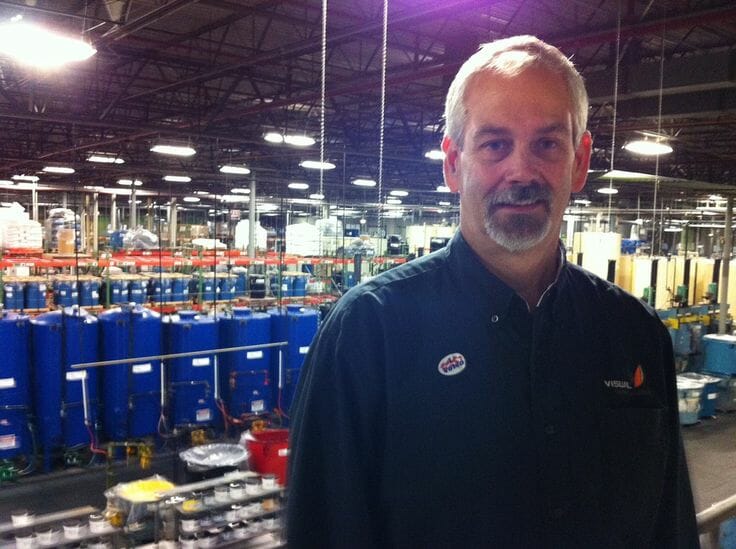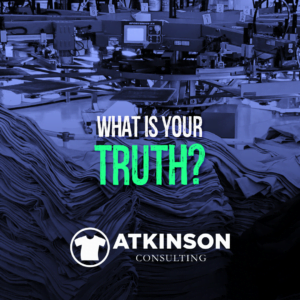If they were all in one room, what would you say if you could gather up a bunch of the leading ink, chemical, screen mesh, equipment and supply distributors for the decorated apparel industry? Would you share all of your thoughts and opinions?
Well, that just happened to me!
Recently I was honored to address a group of the leading suppliers in our industry at a special meeting in Atlanta. It was a wonderful event, and I was extremely happy to give the keynote address. My speech revolved around sustainability, and the future of the decorated apparel industry as a whole. The entire talk was positioned from the printer’s perspective, and was based on linking shop success with ideas and innovations from our supply chain.
Here’s the list of challenges I presented to the group to understand things better from our point of view as decorators. Which of these is most crucial for your shop?
More Output with Less Labor – As any business will tell you, labor is the number one expense that has to be controlled. Shops are constantly looking for ways to produce more with less labor dollars tied to the effort. As suppliers, when they think of their product, can it solve this dilemma? Will it make the shop more efficient labor-wise and help us produce more finished shirts at the end of the day with less people working on the order? If something used to have five steps to complete, can we now do it with three? How can we get the same result, but touch things less during the process? Is it a new gizmo, technique or process? If it does solve this challenge, can you demonstrate or show us to prove it?
Better Consumables – Consumables are all the products we use daily in our shops. Ink, emulsion, mesh, solvents, tape, boxes, thread, pellon, chemicals, shrink-wrap, glue and everything else, it’s all the stuff we constantly churn through daily. Shops constantly buy this stuff, and we all have our favorite brands (Usually though, it’s because “that’s what we’ve always used”). The one thing though that we’re after are products that work better. Every product has its pain point and can be improved. More opacity for ink. Quicker exposure time for emulsion. Retaining higher tension for screens. Less thread breakage for embroidery. Less VOC’s for solvents. As manufacturers of these products it’s up to them to build a better mousetrap. Performance counts.
Think About Packaging – Everything we buy is shipped to us in a bucket, box, barrel, crate or some sort of container. Sometimes these are reused, sometimes these are recycled. Probably a good bit of the time they are just thrown away. How can our supply chain improve on this? Does every dress shirt that we embroider need to be sealed in a plastic bag, with cardboard in the collar, pins to hold it in place, and plastic clips everywhere? Can that drum of emulsion or ink be returned to refill it with more product, instead of just slicing off the top of the drum and turning it into a trash can? Could there be some sort of easy way to check in your product with a bar-code on the package, so we can receive it into our system easier? How can our supply chain rethink how they are packaging and shipping their products to us? Could the outside of the package have a QR code that links to the product spec sheet or SDS sheet for quicker retrieval?
Better Training – One phrase I’ve heard continuously in my career in the decorated apparel industry is “Ink Don’t Think”; meaning that this product is made to do one thing and if you aren’t using it correctly then you won’t achieve the result it was designed to produce. When launching new products into the marketplace, how many companies spend any time focusing on the users to ensure that they are using it properly? Give a shop a bucket of ink to try, and they probably just shove it out on the floor. The production guy slaps it into a screen, they pull a print and it looks awful. “This ink sucks.” Compare that to truly putting some effort into training the printer to ensure that all the variables are correct when using the new ink. Mesh, tension, intended garment, dryer temperature, flash dwell times, squeegee durometer…these are all interconnected. Our suppliers spend a lot of money on developing new products, and money marketing them to the industry. More time training the end user in using the product correctly could help tremendously as well. How are they going about it? Are they offering in-shop support to learn to use the product? Can we pull up a how-to video on the internet? More often than not, there’s little support. There’s an assumption that everyone knows what they are doing.
Better Customer Service & Support – Let’s face it, when someone from a shop calls or e-mails a manufacturer with some equipment down it’s already a stressful situation. We’re on the clock. It’s ticking like a bomb. We need to resolve the challenge now, as we have orders that have to ship, employees standing around (well, actually I hope they are doing something), and customers breathing down our neck. The absolute last thing we want to hear is that the only person that we can talk to about our problem is at lunch, and he’ll call us back in an hour or so. Sorry, but last time I checked cell phones work everywhere. Hire more staff. Work out a coverage schedule. Build a website where we can look up the part number, and order whatever we need without actually talking to anybody. Better, maybe suppliers should think about how they can provide the answers before the questions are asked. The thing to understand is to own the “voice of the customer” and make it easy to do business with you. When you accomplish that feat, everything else follows.
Better Social Media – Before the talk I Googled up everyone on the attendance list and checked out their social media sites. Some companies had really well run social media programs and were truly masters of their game. Others hadn’t been updated since 2009. There was a stark and apparent difference. Why is social media so valuable? Easy. It allows you to send out information regarding what’s going on with your company. Have a new product coming out? You can use social media such as LinkedIn, Twitter or Instagram as your press release guide, Facebook to connect with the shops using it on a personal level, and even post a YouTube video or blog describing how to use the product. Not only that, but it’s basically all free. All they have to do is post. This is how everyone is working and staying connected. We’re in the information age now, and if you aren’t participating in the conversation you are leaving room for your competition’s voice to be the only one speaking.
Support Other Languages – At Visual Impressions we have English, Spanish and Hmong speaking employees. It’s difficult to train everyone on everything our supply chain provides if all instruction manuals and guidebooks are only available in English. Help us get more people using your products correctly without having to have a translator. If you do have this information available, make it easy to find.
Equipment Sustainability Grant Money – A short while ago, Visual Impressions (where I’m the COO) secured a large amount of grant money to help us acquire a new Kornit Avalanche direct to garment printer, based on the fact that we were able to prove that DTG technology uses significantly less energy than printing t-shirts with screens. This grant money came from the manufacturing sector from the City of Milwaukee’s sustainability programs. If we can get this money, other companies can too. Maybe one way equipment manufacturers can help shops buy newer equipment would be to assist in doing some of the legwork for other possible grant money streams. Want to revitalize American industry? Help us compete by placing more efficient equipment in our shops and making it more affordable. Grant money and low interest loans are available, so why not take advantage of it?
Equipment with Lower Energy Usage – The cost of energy always seems to be going up. One way shops can help find more margin is by locating more opportunities to lower their operational costs. Equipment that is engineered to use less energy is one way that it an easily happen. For a lot of shops, their machines operate just about non-stop. Doing the same process with less energy can mean a bigger bottom line. Equipment manufacturers that understand this and can demonstrate these savings will win. Show us the money and help us calculate the ROI on the equipment or process your item uses.
More Information – More Connectivity – I don’t know about your shop, but we spend a considerable amount of time scheming on how we are going to get everything completed and shipped correctly, and of course, by the in-hands date. It’s daily, if not weekly, puzzle we have to solve. Information is the key to that process. The more information we have available at our fingertips, the easier it is to make a decision that can unblock a log jam, or push something out until next week. Is the file digitized? Are the screens burned? How fast is Press #2 running today, now that the usual printer is out with the flu and a stand-in is running the press today? Will we need overtime on Saturday, based on the schedule on Tuesday? Recording and distributing this information allows schedulers and managers to make better decisions to keep things on track. Imagine if all of our departments, equipment, and schedules meshed together and were available on one dashboard? A shop speedometer could help with that tremendously.
Help with Turn Times – One thing is for sure, and that’s customers are not giving us more time to produce their order. I can remember when 7-10 business days used to be the norm for most orders. Now, it’s more like 5-7. We do a lot of jobs in 3, and in fact have a few clients that pay for jobs to be run in 1 day. The internet and market competition are forcing our turn times and production responsiveness speeds to dramatically increase. Digital printing is going to be the solution for that for a lot of shops, but that doesn’t help with everything. Anything that takes big steps out of the workflow and saves us chunks of time is a big blessing. It’s all about shoving more through the pipe.
Help with Print Quality – At our heart, all print and embroidery shops are run by craftsman. We want quality. However, this is becoming harder and harder to keep up with as new fabrics, demands by the consumer, turn-time stress, and any other factors that are disrupting the industry. The more solutions we have to use the better. Getting these to market and then training the industry on how to use them; or sometimes even how to recognize that you need to use them, is crucial.
Support Greener Supply Chain Initiatives – Our industry runs with a lot of waste. Injecting a healthy dose of sustainability into this industry could save shops a lot of money and help them run more efficiently. For suppliers and manufacturers, there doesn’t seem to be much thinking along these lines, at least overtly. A more concerted effort could really help the decorated apparel industry, especially smaller shops as they tend to not think about lean manufacturing or six sigma principles as much. From the supply chain perspective, supporting initiatives such as the Sustainable Green Printing Partnership with financial backing, and assisting shops in becoming sustainably certified printers could make this a stronger, more resilient, and more profitable industry.
So there you have it. My talk was well received, and I have heard back from many of the attendees. They took some of my challenges to heart and have followed up with their staff regarding the ones that hit home with them. However, I’m interested to know what you think. What did I leave out? Given the opportunity, what would you have asked or challenged them to build for you? Leave a comment below, or shoot me an e-mail at matkinson4804@gmail.com.






3 comments
Gary Jones
Marshall – Excellent blog post! You have identified many opportunities for improvement and highlighted the need for companies to incorporate sustainability into their supply chain. Almost every topic you touched upon has an element of sustainability associated with it.
Tony
I didn’t finish reading your article yet, but I’m curious on how long it took you to prepare for your presentation?
atkinsontshirt
Tony – Thanks for reading!
A few weeks for the presentation, but probably a career’s worth of pushing orders through the system. I talked to a few people too… -M